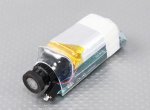So to preface, in 2006 I launched two high altitude weather balloons equipped with cameras, Picaxe, GPS and UHF radios. I tracked them from Melbourne, Victoria to the NSW border. It was a great little project, and a few people got involved along the way.
Now I am thinking of doing some deep sea underwater photography, in the small chance I can find some creatures that humans have not discovered yet.
The idea is to build a device that can withstand the pressure of the ocean at 10Km under water. This is around 15000 PSI or about one tonne per square cm.
To keep things simple, the device won't have any propulsion at all. It will be dropped from a ship, at which point it will sink to the sea floor, take photos of moving objects for about a month or so, then automatically resurface and hopefully be retrieved. The idea is that there will be a camera, LEDs, and some sort of motion detection to only capture the events that may be interesting. This would involve some sort of optical motion sensor, as using sonar, or IR sensors is not suitable at these depths. I think that a low power LED could be turned on to attract any creatures, and some high power LEDs could be turned on while filming or taking photos.
So far, I think the best option is to have the craft comprise of three main sections, all joined with a galvanised chain. The top section will be for flotation, consisting of an incompressible, lighter than water, substance such as motor oil or kerosene. (fully sealed of course)
The middle section will be the camera, beacon, LEDs and electronics, and the bottom section will be some sort of weight such as a large stone.
I propose that after a certain elapsed time, the stone will disconnect from the electronics enclosure, and the electronics, and float will resurface and be rescued. The stone will remain at the bottom of the sea floor.
I have two questions that I would like input on. One is how to do the motion capture. I was thinking of using an optical mouse with a suitable lens for crude vision detection. Comments? Anyone done this with a picaxe?
The other question is how to release the weight. I was thinking of using a seatbelt pretensioner that pulls a pin out and releases the chain. Not sure how these go at high pressures tho. I could have it inside its own oil bath, but again, not sure if it will work at high pressure.
The other idea I had was to use two dissimilar metals for the chain, so that galvanic corrosion would eat away at the link, and sooner or later, would release the camera and float. The disadvantage of this being that you could not time it to release at an exact moment, hence the recovery of the camera would be less certain.
Appreciate any other ideas. I'm just at the planning phase at the moment.
Now I am thinking of doing some deep sea underwater photography, in the small chance I can find some creatures that humans have not discovered yet.
The idea is to build a device that can withstand the pressure of the ocean at 10Km under water. This is around 15000 PSI or about one tonne per square cm.
To keep things simple, the device won't have any propulsion at all. It will be dropped from a ship, at which point it will sink to the sea floor, take photos of moving objects for about a month or so, then automatically resurface and hopefully be retrieved. The idea is that there will be a camera, LEDs, and some sort of motion detection to only capture the events that may be interesting. This would involve some sort of optical motion sensor, as using sonar, or IR sensors is not suitable at these depths. I think that a low power LED could be turned on to attract any creatures, and some high power LEDs could be turned on while filming or taking photos.
So far, I think the best option is to have the craft comprise of three main sections, all joined with a galvanised chain. The top section will be for flotation, consisting of an incompressible, lighter than water, substance such as motor oil or kerosene. (fully sealed of course)
The middle section will be the camera, beacon, LEDs and electronics, and the bottom section will be some sort of weight such as a large stone.
I propose that after a certain elapsed time, the stone will disconnect from the electronics enclosure, and the electronics, and float will resurface and be rescued. The stone will remain at the bottom of the sea floor.
I have two questions that I would like input on. One is how to do the motion capture. I was thinking of using an optical mouse with a suitable lens for crude vision detection. Comments? Anyone done this with a picaxe?
The other question is how to release the weight. I was thinking of using a seatbelt pretensioner that pulls a pin out and releases the chain. Not sure how these go at high pressures tho. I could have it inside its own oil bath, but again, not sure if it will work at high pressure.
The other idea I had was to use two dissimilar metals for the chain, so that galvanic corrosion would eat away at the link, and sooner or later, would release the camera and float. The disadvantage of this being that you could not time it to release at an exact moment, hence the recovery of the camera would be less certain.
Appreciate any other ideas. I'm just at the planning phase at the moment.

